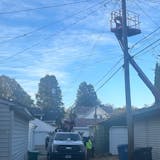The so-called "yellow-vest" protest that erupted in recent weeks in France was, at least initially, a protest from rural citizens over a significant fossil-fuel tax increase proposed by French President Emmanuel Macron to further combat climate change.
Macron's laudable goal was to reduce his country's dependence on fossil fuels while accelerating the conversion to nonpolluting fuels in line with the international Paris climate accords. The fiery backlash forced him to retrench — tragic for the climate, good in the short term for rural citizens.
I can see a similar protest brewing in Minnesota if the new administration of Gov.-elect Tim Walz is not circumspect as it follows through on its campaign support for a long-overdue 25-cent-per-gallon increase in Minnesota's gasoline tax. Rural Republican legislators are already lining up against it. How to bridge that gap?
Make no mistake, the funds are needed, both to repair and maintain Minnesota's neglected road and bridge infrastructure because gas-tax revenue has not kept up with inflation, and to continue the state's attack on carbon pollution that is permanently altering the climate with already serious financial and environmental consequences.
But the fossil-fuel budget of rural citizens, especially farmers, can be substantial — when you have to drive your pickup 40 miles to the feed store and truck crops to market, in contrast to metro residents with generally easy access to work and the things they need. This difference may explain much of the difference in response to climate change in urban vs. rural America, and now between rural and urban France.
What is the solution to this conundrum? I am sure the governor's cabinet and the Legislature are working hard on it, but here are a few modest suggestions about how to begin to place the burden — and the opportunities — of the new electric economy where they belong, on all of us:
First, the good news. Some rural areas are already benefiting from wind farms on properties, plus a growing number of solar farms. That is doubly beneficial, as renewable electricity is the cheapest fuel of the moment and the future, as Xcel demonstrated last week with its formal commitment to 100 percent renewable power by 2050. But how to further spread the costs and benefits to everyone, including rural areas?
Begin by devoting a portion of the budget surplus to subsidizing the rural sector's transition to renewable energy. The University of Minnesota's Institute on the Environment and School of Agriculture, along with Xcel, Great River Energy, Minnesota Power and rural cooperatives, should cooperate to build a demonstration electric farm on the state fairgrounds. And subsidize animal waste systems that capture methane and produce electricity.

